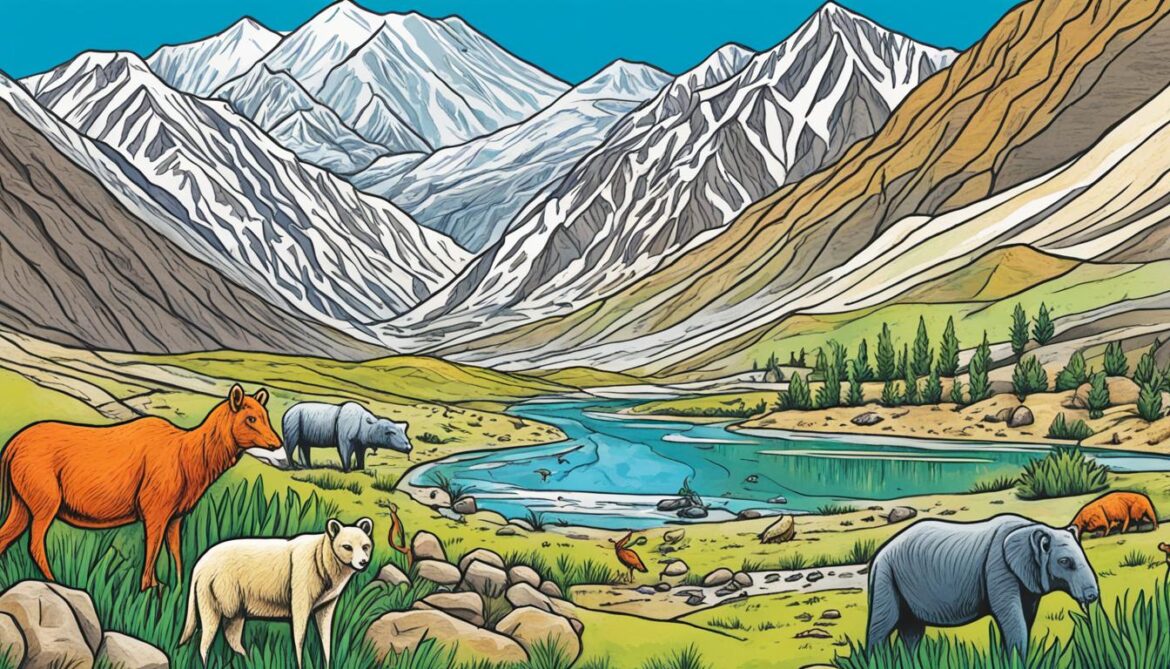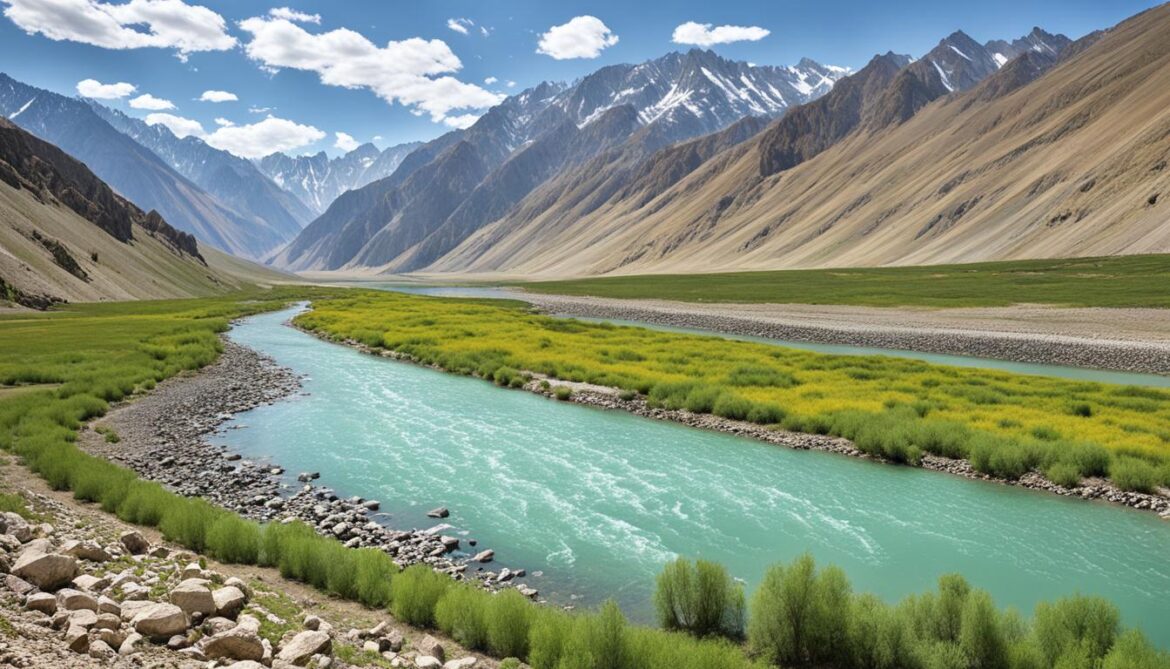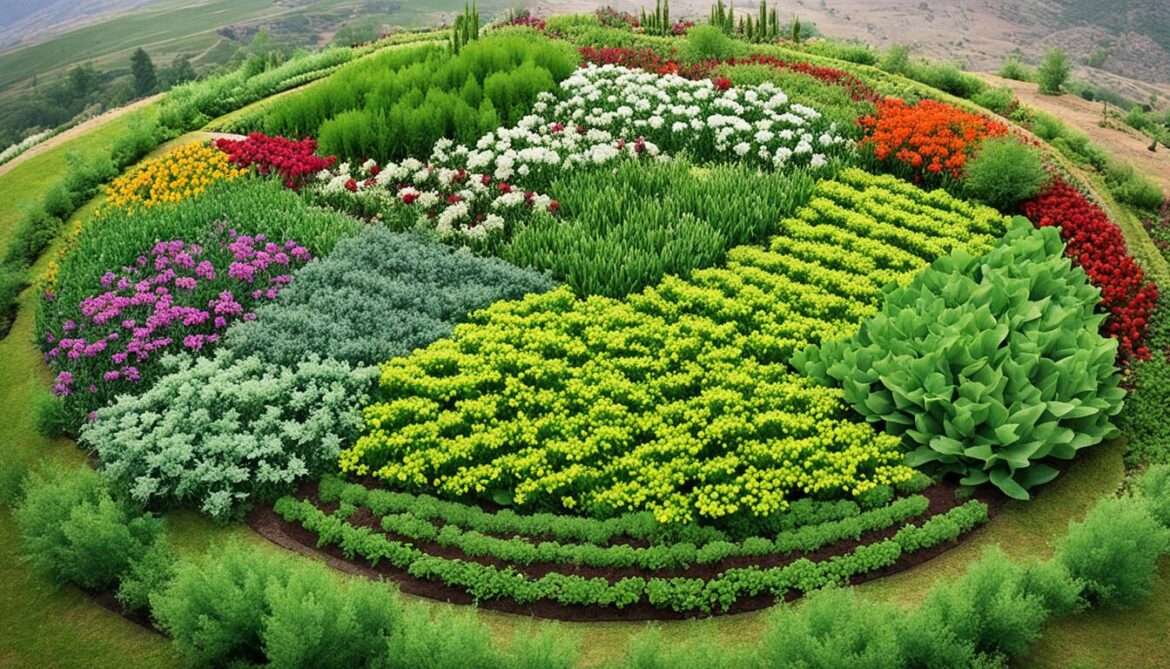Did you know that Tajikistan, a landlocked country in Central Asia, is home to over 23,300 species of flora and fauna? With more than 164 species per thousand square kilometers, Tajikistan boasts a remarkable level of biodiversity that is simply awe-inspiring. From majestic snow leopards to vibrant wildflowers, this diverse ecosystem is a treasure trove of natural wonders.
Over the years, Tajikistan has recognized the importance of conserving its natural diversity and has taken significant steps towards biodiversity conservation and sustainability. The country has a comprehensive National Strategy and Action Plan on the Conservation and Sustainable Use of Biodiversity, focusing on the economic and social evaluation of biological resources, genetic pool conservation, biodiversity conservation, biological safety, and the sustainable use of biological resources.
As we delve deeper into the world of Tajikistan’s biodiversity, let’s explore the efforts being made to protect this valuable natural heritage.
Key Takeaways:
- Tajikistan is home to over 23,300 species of flora and fauna.
- The country has a National Strategy and Action Plan on the Conservation and Sustainable Use of Biodiversity.
- Efforts are being made to evaluate and conserve biological resources, genetic pools, and biodiversity.
- Conservation measures include the ratification of the Nagoya Protocol and the conservation of genetic resources.
- Tajikistan faces challenges such as climate change and habitat destruction, necessitating continued efforts to preserve biodiversity.
Implementation of the NBSAP
Tajikistan’s National Strategy and Action Plan on the Conservation and Sustainable Use of Biodiversity (NBSAP) was adopted in 2003, focusing on the evaluation and conservation of biological resources, genetic pool conservation, biodiversity conservation, biological safety, and sustainable use of resources. The NBSAP plays a crucial role in safeguarding Tajikistan’s rich natural heritage and promoting the sustainable management of its biological diversity.
The NBSAP identifies 15 key priorities for biological conservation, addressing a wide range of challenges and opportunities. One of the priorities is the creation of a national ecological network, which aims to connect and protect diverse ecosystems across the country. By establishing this network, Tajikistan can enhance habitat connectivity, preserve genetic diversity, and ensure the long-term survival of its unique flora and fauna.
The NBSAP also emphasizes the conservation of each ecosystem, recognizing the importance of maintaining the integrity and functionality of specific habitats. Through targeted conservation efforts, Tajikistan can protect critical ecosystems such as forests, wetlands, and grasslands, which provide essential services such as carbon sequestration, water regulation, and habitat provision for countless species.
In line with the Aichi Biodiversity Targets, Tajikistan is working towards updating and aligning the NBSAP with global conservation priorities. The Aichi Targets, adopted under the Convention on Biological Diversity, provide a comprehensive framework for biodiversity conservation and sustainable development. By incorporating the Aichi Targets into the NBSAP, Tajikistan can ensure that its conservation efforts are harmonized with international standards and best practices.
“The implementation of the NBSAP is a critical step towards achieving our goals of biodiversity conservation and sustainable development. By protecting our biological resources, conserving our genetic pool, and ensuring biodiversity safety, we can secure a sustainable future for Tajikistan’s natural heritage.” – Minister of Environment and Natural Resources of Tajikistan
Tajikistan has taken several actions to implement the NBSAP and achieve its conservation objectives. For instance, the country has ratified the Nagoya Protocol, an international agreement that promotes the fair and equitable sharing of benefits derived from the utilization of genetic resources. This ratification demonstrates Tajikistan’s commitment to responsible and sustainable use of genetic resources while safeguarding biodiversity.
Tajikistan is also actively engaged in the conservation of genetic resources of wild fruit. These resources play a crucial role in maintaining biodiversity, providing ecosystem services, and supporting livelihoods in rural communities. Through targeted conservation efforts, Tajikistan is protecting and preserving the genetic diversity of wild fruit species, ensuring their long-term survival and enabling future generations to benefit from their genetic traits.
Benefits of NBSAP Implementation
The implementation of the NBSAP offers numerous benefits for Tajikistan’s biological resources, biodiversity conservation, and sustainable development. Some of these benefits include:
- Conservation of genetic pool: By prioritizing genetic pool conservation, Tajikistan can safeguard the genetic diversity of its plant and animal species. This diversity serves as a valuable resource for future adaptation, resilience, and the development of new varieties.
- Enhanced biodiversity safety: Implementing the NBSAP improves biodiversity safety by protecting endangered species, preserving critical habitats, and mitigating the threats posed by habitat degradation, climate change, and invasive species.
- Sustainable use of biological resources: The NBSAP promotes the sustainable utilization of biological resources, ensuring that they are managed in a way that maintains their long-term availability and benefits present and future generations.
- Ecosystem services: By conserving biological resources and habitats, the NBSAP contributes to the provision of essential ecosystem services, including clean air and water, pollination, soil fertility, and climate regulation.
The NBSAP implementation is a vital step towards securing Tajikistan’s biodiversity and sustaining the well-being of its people for generations to come. By adopting a holistic and strategic approach to conservation, Tajikistan can protect its unique natural heritage while fostering sustainable development.
National Center for Biodiversity and Biosafety (NBBC)
The National Center for Biodiversity and Biosafety (NBBC) plays a vital role in coordinating biodiversity conservation efforts in Tajikistan. As the central coordinating body, the NBBC ensures the effective implementation of the biodiversity action plan and monitors the progress of the National Strategy and Action Plan on the Conservation and Sustainable Use of Biodiversity (NBSAP).
One of the key responsibilities of the NBBC is to create a comprehensive data bank on the diversity of flora and fauna in Tajikistan. This data bank serves as a valuable resource for researchers, conservationists, and policymakers, providing accurate and up-to-date information on the country’s rich biodiversity.
Furthermore, the NBBC actively engages with governmental institutions, local authorities, scientific organizations, and non-governmental organizations (NGOs). Through these collaborations, the NBBC aims to attract donors and secure funding for various conservation projects in Tajikistan.
“The NBBC’s efforts are crucial for the effective implementation of the NBSAP and the conservation of Tajikistan’s biodiversity. By coordinating conservation projects and establishing partnerships with stakeholders, the NBBC plays a significant role in protecting the unique ecosystems and species that make Tajikistan’s biodiversity so remarkable.”
With its dedicated team and collaborative approach, the NBBC ensures that conservation efforts in Tajikistan are well-coordinated and aligned with the goals of the NBSAP. By monitoring the implementation of the action plan and supporting relevant initiatives, the NBBC takes proactive steps to safeguard the country’s biodiversity for future generations.
Conservation Projects Supported by the NBBC
| Project Name |
Focus Area |
Partner Organizations |
| Restoration of Wetland Ecosystems |
Wetland Conservation |
Tajikistan Ecological Association, Ramsar Convention Secretariat |
| Protection of Endangered Species |
Species Preservation |
Tajikistan Wildlife Conservation Society, IUCN |
| Sustainable Forest Management |
Forest Conservation |
Tajikistan Forestry Agency, World Wildlife Fund |
| Community-based Conservation |
Local Engagement |
Tajikistan Nature Society, Snow Leopard Foundation |
This table highlights some of the conservation projects supported by the NBBC. These initiatives target various focus areas, including wetland conservation, species preservation, forest conservation, and local engagement. Through partnerships with organizations and the allocation of resources, the NBBC contributes to the successful implementation of these projects and the overall preservation of Tajikistan’s biodiversity.
Status of Biodiversity
Tajikistan boasts a remarkable biodiversity status, characterized by a diverse array of ecosystems and species. The country encompasses major ecoregions, including deserts, steppes, forests, meadows, and wetlands. Such varied habitats support a thriving ecosystem that sustains over 23,300 species of flora and fauna.
With more than 164 species per thousand square kilometers, Tajikistan exhibits a remarkable species diversity. Its unique ecological landscapes have fostered the emergence of endemic and rare species, making it a biodiversity hotspot. However, the conservation of several species is a matter of concern, as they face the threat of extinction and feature in the Red Data Book of Tajikistan.
One pressing issue that requires immediate attention is the loss of agrobiodiversity. As climate change continues to impact the region, the resilience and diversity of agricultural crops are at risk. Ensuring the preservation and protection of the country’s agrobiodiversity is crucial for sustaining agriculture and promoting economic sustainability in Tajikistan.

Biodiversity Conservation in Tajikistan
Tajikistan has taken significant steps to conserve its rich biodiversity by establishing protected areas such as national parks, nature reserves, and sanctuaries. These protected areas play a crucial role in preserving the unique ecosystems and endangered species found in the country.
One of the key contributors to biodiversity conservation in Tajikistan is agriculture. Traditional farming practices have not only sustained local communities but have also contributed to the development of agricultural crops. By preserving traditional farming techniques and promoting sustainable agricultural practices, Tajikistan ensures the conservation of agrobiodiversity, protecting both plant and animal species.
However, forests in Tajikistan have faced challenges due to deforestation. The loss of forest ecosystems has not only impacted biodiversity but also affected the livelihoods of local communities. To address this issue, efforts are being made to conserve and restore forest ecosystems, safeguarding the habitats and resources they provide.
Overall, biodiversity conservation in Tajikistan relies on the establishment of protected areas, the preservation of traditional farming practices, and the restoration of forest ecosystems. These measures aim to protect the natural diversity of Tajikistan, ensuring the sustainability of its ecosystems and the well-being of its flora and fauna.

| Protected Areas |
Agriculture |
Forests |
– National parks
– Nature reserves
– Sanctuaries |
– Preservation of traditional farming practices
– Sustainable agriculture |
– Conservation and restoration efforts
– Protection of forest ecosystems |
Strategy and Policy Framework
Tajikistan recognizes the importance of a strong institutional framework for the effective conservation of biodiversity. The country has established the National Biodiversity and Biosafety Center (NBBC) and government working groups to coordinate and implement conservation efforts. These institutions play a key role in supporting and guiding biodiversity conservation initiatives in Tajikistan.
Non-governmental organizations (NGOs) are critical partners in the implementation of Tajikistan’s National Strategy and Action Plan on the Conservation and Sustainable Use of Biodiversity (NBSAP). NGOs work alongside government agencies and the NBBC to promote biodiversity conservation, raise awareness, and contribute valuable expertise and resources. Their active involvement enhances the success and impact of biodiversity conservation efforts in Tajikistan.
Tajikistan has also established a robust legislative framework to protect biodiversity and regulate its use. As part of this framework, regulations for biosafety and the introduction of genetically modified organisms have been put in place. These regulations ensure the responsible management of biodiversity resources and promote the sustainable use of genetic resources in Tajikistan.
The National Biodiversity and Biosafety Center (NBBC)
The National Biodiversity and Biosafety Center (NBBC) is the central coordinating body for biodiversity conservation in Tajikistan. Working in collaboration with various stakeholders, the NBBC plays a crucial role in mainstreaming the NBSAP and ensuring the effective implementation of conservation strategies.
The NBBC’s responsibilities include:
- Coordinating the implementation of the NBSAP and associated programs
- Creating a comprehensive data bank on flora and fauna diversity
- Attracting financial and technical support from donors for biodiversity conservation projects
- Monitoring and evaluating the progress of biodiversity conservation initiatives
The NBBC works closely with government institutions, local authorities, scientific organizations, and NGOs to establish a collaborative and multi-stakeholder approach to biodiversity conservation in Tajikistan.

Table: Legislative Framework for Biodiversity Conservation in Tajikistan
| Regulations |
Objective |
| Biosafety regulations |
Ensure the safe handling and use of genetically modified organisms |
| Regulations on conservation areas |
Designate protected areas and establish conservation measures |
| Regulations on genetic resources |
Regulate the access and utilization of genetic resources |
“The institutional framework and legislative mechanisms in Tajikistan provide a solid foundation for biodiversity conservation. The collaboration between the National Biodiversity and Biosafety Center, government agencies, and NGOs is essential for achieving the goals of the National Strategy and Action Plan on the Conservation and Sustainable Use of Biodiversity.” – Dr. Alisher Baboev, Biodiversity Expert
Research and Development
The Institute of Botany, Physiology, and Plant Genetics in Tajikistan plays a crucial role in the field of biodiversity research. Through its comprehensive research and development activities, the institute contributes to the conservation and sustainable use of biodiversity.
The researchers at the Institute of Botany focus on studying various research areas related to biodiversity, including:
- Flora and Plant Taxonomy
- Ecology and Plant Resources
- Molecular Biology and Plant Biotechnology
- Genetics and Plant Breeding
The dedicated scientists at the institute apply cutting-edge techniques and methodologies to investigate the unique flora and plant species found in Tajikistan. Their research efforts lead to a deeper understanding of plant diversity, ecological interactions, and the genetic makeup of different plant species.
By studying the genetics and breeding of plants, the institute aims to develop resilient and adaptable crop varieties that can withstand various environmental stresses and contribute to sustainable agricultural practices.
Institute of Botany’s Research Areas
The Institute of Botany’s research areas include:
- Investigating the taxonomic classification and distribution patterns of flora in Tajikistan
- Assessing the ecological roles and economic potential of plant resources
- Exploring the molecular mechanisms underlying plant development and stress responses
- Utilizing genetic markers and biotechnological tools to enhance crop breeding strategies
Through their multidisciplinary research and collaboration with other national and international institutes, the Institute of Botany continues to expand scientific knowledge, promote biodiversity conservation, and contribute to the sustainable development of Tajikistan’s plant resources.
| Research Areas |
Focus |
| Flora and Plant Taxonomy |
Classification and distribution of flora in Tajikistan |
| Ecology and Plant Resources |
Evaluation of ecological roles and economic potential of plant resources |
| Molecular Biology and Plant Biotechnology |
Investigation of molecular mechanisms in plant development and stress responses |
| Genetics and Plant Breeding |
Application of genetic markers and biotechnological tools in crop breeding |

Importance of Plant Genetic Resources
Plant genetic resources play a strategic role in agricultural and economic development in Tajikistan. They provide the basis for agricultural and food security, contributing to national sovereignty and sustainable agriculture. Tajikistan, known as the birthplace of many agricultural crops, boasts a rich diversity of plant species that are essential for the country’s agricultural sustainability.
The preservation of agrobiodiversity is crucial as it ensures the adaptability of local crops to changing climates and environmental conditions. It also supports sustainable farming practices and promotes economic growth within the agricultural sector. The loss of agrobiodiversity poses a significant concern, emphasizing the need to safeguard and enhance the adaptive capacity of communities.
By conserving and utilizing plant genetic resources, Tajikistan can foster agricultural and economic sustainability, ensuring the long-term viability of its agricultural sector and food production. The continuous exploration and preservation of plant genetic resources are vital for addressing the challenges posed by climate change and securing a prosperous future for Tajikistan’s agriculture.
Benefits of Plant Genetic Resources:
- Enhanced agricultural productivity through the development of high-yielding and disease-resistant crop varieties
- Increased resilience of crops to environmental stresses, such as drought, pests, and diseases
- Promotion of sustainable farming practices
- Improved nutritional content of food crops
- Preservation of traditional and indigenous knowledge related to plant breeding and farming techniques
| Plant Genetic Resources |
Impact on Agricultural Development |
Contribution to Economic Sustainability |
| Rich diversity of local plant species |
Provides the foundation for sustainable agriculture and food security |
Strengthens the agricultural sector and boosts rural economies |
| Variety of crop cultivars and wild relatives |
Enables the development of high-yielding and disease-resistant crop varieties |
Increases agricultural productivity and export potential |
| Preservation of traditional farming practices |
Maintains cultural heritage and promotes sustainable land management |
Promotes ecotourism and rural livelihoods |
Preserving and utilizing plant genetic resources is vital for Tajikistan’s agricultural development and economic sustainability. The country’s commitment to conservation efforts and the promotion of sustainable farming practices will contribute to the long-term well-being of both the environment and the communities relying on it.

Institute of Botany, Physiology, and Plant Genetics
The Institute of Botany, Physiology, and Plant Genetics is a renowned research institution in Tajikistan. Through its comprehensive scientific studies, the institute contributes significantly to the understanding and utilization of the country’s plant species biodiversity.
Research conducted at the institute encompasses a broad range of disciplines, including:
- Systematic composition of flora
- Botanical resource science
- Geobotanical research
- Plant physiology
- Biochemistry
- Genetics
- Biotechnology

The diverse areas of research undertaken by the institute enable a comprehensive exploration of Tajikistan’s plant kingdom. By studying the systematic composition of flora, scientists gain valuable insights into the classification and distribution of plant species across the country. Botanical resource science focuses on understanding the ecological significance and sustainable use of plant resources, emphasizing conservation efforts.
Geobotanical research at the institute aims to investigate the relationship between plants and their environment, including their distribution patterns and adaptations to specific ecological conditions. Such knowledge is crucial for effective conservation practices and managing ecosystems for long-term sustainability.
Plant physiology and biochemistry research shed light on the physiological processes and biochemical mechanisms that drive plant growth, development, and adaptation to various environmental conditions. This knowledge is essential for understanding plant responses to stressors and designing strategies to enhance plant productivity and resilience.
Additionally, the institute’s expertise in genetics and biotechnology contributes to advancements in plant breeding, genetic resource conservation, and biotechnological applications for the sustainable development of agriculture and horticulture in Tajikistan.
Research Areas at the Institute of Botany, Physiology, and Plant Genetics
| Research Area |
Description |
| Systematic Composition of Flora |
Classification and distribution of plant species in Tajikistan |
| Botanical Resource Science |
Evaluation and sustainable utilization of plant resources |
| Geobotanical Research |
Study of plant-environment relationships and distribution patterns |
| Plant Physiology |
Investigation of plant growth, development, and adaptation processes |
| Biochemistry |
Understanding the biochemical mechanisms in plants |
| Genetics |
Research on plant genetics and genetic resource conservation |
| Biotechnology |
Application of biotechnological tools for plant improvement |
Conservation Challenges and Threats
Tajikistan faces various conservation challenges and threats to biodiversity. The impacts of climate change pose significant risks to the country’s ecosystems and species. Rising temperatures and changes in rainfall patterns have resulted in hotter weather, insufficient rainfall, and an imbalance in natural habitats. These factors have a direct negative impact on the survival and reproductive capabilities of plants and animals.

Habitat destruction, including deforestation and changes in land use, further exacerbates the threat to biodiversity in Tajikistan. The clearing of forests for agricultural purposes and urbanization disrupts ecosystems and disrupts the delicate balance required for species survival. This loss of natural habitats reduces available resources and causes a decline in species populations.
“The destruction of habitats is one of the primary drivers of biodiversity loss worldwide. Tajikistan is not immune to this threat, and urgent action is needed to mitigate the negative consequences.” – Dr. Akram Abdilov, Conservation Biologist
Tajikistan also faces the challenge of biodiversity loss due to climate change. The shifting climate patterns impact the delicate balance of plant and animal species, leading to shifts in their distribution and potential extinction. These changes further contribute to the loss of genetic diversity and disrupt the intricate web of interactions within ecosystems.
To address these conservation challenges and ensure the preservation of Tajikistan’s unique biodiversity, comprehensive efforts are needed. This includes:
- Implementing sustainable land use practices to mitigate habitat destruction and promote biodiversity conservation
- Enhancing climate change resilience through the preservation and restoration of natural habitats
- Establishing protected areas and implementing effective conservation strategies
- Strengthening international cooperation and partnerships to address global challenges
The preservation of Tajikistan’s biodiversity is crucial not just for the country but also for global efforts to combat climate change and protect the delicate balance of ecosystems. By addressing these challenges head-on, Tajikistan can contribute to the wider global goal of ensuring a sustainable and biodiverse future.
Conclusion
Tajikistan’s biodiversity is a valuable natural resource that requires conservation and protection. The country has made significant progress in this regard by implementing the National Strategy and Action Plan on the Conservation and Sustainable Use of Biodiversity (NBSAP) and working towards achieving the Aichi Biodiversity Targets. Through the National Center for Biodiversity and Biosafety (NBBC), biodiversity conservation efforts are being coordinated, and stakeholders from various sectors are actively engaged.
However, challenges such as climate change and habitat destruction continue to threaten the biodiversity of Tajikistan. The impacts of climate change, including rising temperatures and changes in rainfall patterns, have negative consequences for ecosystems and species. Habitat destruction, particularly through deforestation and changes in land use, further exacerbates biodiversity loss. Addressing these challenges requires ongoing efforts and the development of sustainable solutions.
To ensure the long-term sustainability of Tajikistan’s biodiversity, it is essential to continue implementing the NBSAP and aligning conservation measures with the Aichi Biodiversity Targets. Collaborative action involving governmental institutions, local authorities, scientific organizations, and non-governmental organizations (NGOs) is crucial for achieving effective biodiversity conservation. Additionally, awareness-raising and education initiatives can promote a greater understanding of the importance of biodiversity and foster a sense of stewardship towards Tajikistan’s unique ecosystems and species.
In conclusion, safeguarding Tajikistan’s biodiversity is of paramount importance. By addressing challenges such as climate change and habitat destruction, and by continuing to implement conservation strategies, Tajikistan can preserve its rich natural heritage for future generations to enjoy.
FAQ
What is the National Strategy and Action Plan on the Conservation and Sustainable Use of Biodiversity in Tajikistan?
The National Strategy and Action Plan on the Conservation and Sustainable Use of Biodiversity in Tajikistan is a plan that focuses on evaluating and conserving biological resources, genetic pool conservation, biodiversity conservation, biological safety, and sustainable resource use.
What is the role of the National Center for Biodiversity and Biosafety (NBBC) in Tajikistan?
The NBBC is responsible for coordinating biodiversity conservation efforts in Tajikistan. It plays a crucial role in mainstreaming the biodiversity action plan, creating a data bank on flora and fauna diversity, attracting donors for conservation projects, and monitoring the implementation of the National Strategy and Action Plan on Biodiversity Conservation and Sustainable Use.
What is the status of biodiversity in Tajikistan?
Tajikistan is known for its rich biodiversity, with a wide range of ecosystems and over 23,300 species of flora and fauna. The country has major ecoregions such as deserts, steppes, forests, meadows, and wetlands. However, some species are rare and endemic, while others are threatened with extinction and included in the Red Data Book of Tajikistan.
How is biodiversity conserved in Tajikistan?
Tajikistan has established protected areas, such as national parks, nature reserves, and sanctuaries, to conserve biodiversity. These areas help preserve unique ecosystems and endangered species. Agriculture also plays a significant role in biodiversity conservation, as traditional farming practices have contributed to the development of agricultural crops. Efforts are made to conserve and restore forest ecosystems.
What is the institutional framework for biodiversity conservation in Tajikistan?
Tajikistan has an institutional framework in place to support biodiversity conservation, including the National Center for Biodiversity and Biosafety and government working groups. Non-governmental organizations (NGOs) also play a crucial role in implementing the National Strategy and Action Plan on the Conservation and Sustainable Use of Biodiversity in Tajikistan.
What research and development activities are conducted in Tajikistan to conserve biodiversity?
The Institute of Botany, Physiology, and Plant Genetics in Tajikistan conducts research in various areas of biodiversity, including flora, plant taxonomy, ecology, molecular biology, genetics, and plant breeding. The institute’s work contributes to the conservation and sustainable use of biodiversity.
Why are plant genetic resources important in Tajikistan?
Plant genetic resources play a strategic role in agricultural and economic development in Tajikistan. They provide the basis for agricultural and food security and contribute to national sovereignty. The local agrobiodiversity in Tajikistan is crucial for agricultural sustainability, as the country is considered the birthplace of many agricultural crops.
What are the conservation challenges and threats to biodiversity in Tajikistan?
Tajikistan faces challenges and threats to biodiversity, including climate change, habitat destruction, and agrobiodiversity loss. Climate change has negative impacts on ecosystems and species, while habitat destruction, such as deforestation and changes in land use, poses a significant threat. Efforts are needed to address these challenges and ensure the preservation of Tajikistan’s unique biodiversity.
What is the conclusion on biodiversity conservation in Tajikistan?
Tajikistan recognizes the importance of biodiversity conservation and has implemented the National Strategy and Action Plan on the Conservation and Sustainable Use of Biodiversity. Efforts are being made to achieve the Aichi Biodiversity Targets and engage stakeholders in biodiversity conservation. However, challenges such as climate change and habitat destruction must be addressed to ensure the long-term sustainability of Tajikistan’s biodiversity and protect its valuable ecosystems and species.
Source Links

























Post comments (0)